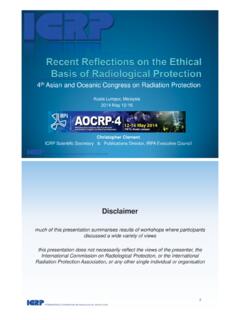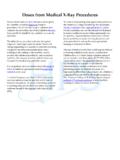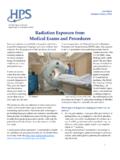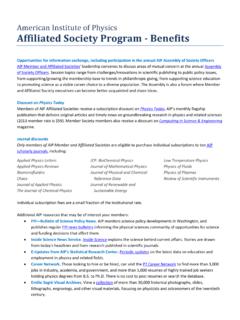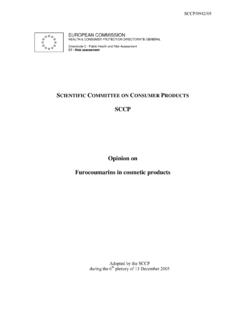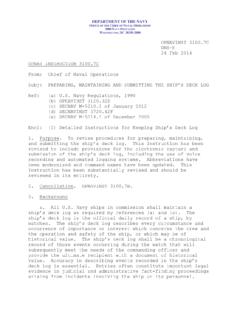Transcription of Environmental Radiation Fact Sheet - Health Physics Society
1 1 Health Physics Society Specialists in Radiation Safety Environmental Radiation fact Sheet Adopted: January 2010 Sources of background Radiation background Radiation (which scientists call ubiquitous background Radiation ) is emitted from both natural and human-made radioactive chemicals (radionuclides). Some naturally occurring radionuclides are found in the earth beneath our feet, while others are produced in the atmosphere by Radiation from space. Human-made radi-onuclides have entered the environment from activities such as medical procedures that use radionuclides to image the body and electricity generation that uses radi-oactive uranium as fuel.
2 Humans are continuously irradiated by sources outside and inside their bodies. Outside sources include space Radiation and terrestrial Radiation . Inside sources include the radionuclides that enter our bodies in the food and water people ingest and the air they breathe. Whatever its origin, Radiation is everywhere (or ubiquitous ) in the environment. Radiation from Space Radiation that enters the Earth s atmosphere from space can come from as close as the Earth s Radiation belts and the sun or as far away as beyond the boundaries of the solar system and even beyond the Milky Way galaxy. Radiation from beyond the solar system has enough en-ergy to generate additional Radiation as it passes through Earth s atmosphere, creating either radionu-clides in the air or secondary particles.
3 Some secondary particles reach the Earth s surface most readily near the magnetic poles where shielding by the Earth s mag-netic field is weakest and at high altitudes where the Earth s atmosphere is thinnest. Radionuclides created by space Radiation are called cosmogenic radionuclides. They include tritium (hydrogen-3), beryllium-7, carbon-14, and sodium-22. Terrestrial Radiation Radiation that originates on Earth is called terrestrial Radiation . Primordial radionuclides (radioactive chemi-cals that were present when the Earth formed about billion years ago) are found around the globe in igneous and sedimentary rock. From rocks, these radionuclides migrate into soil, water, and even air.
4 Human activities such as uranium mining have also redistributed these radionuclides. Primordial radionuclides include the se-ries of radionuclides produced when uranium and tho-rium decay, as well as potassium-40 and rubidium-87. In the past, one human activity that contributed to ter-restrial Radiation was production of nuclear weapons. Today, atmospheric weapons testing is not a significant contributor to background Radiation because fallout has decayed since weapons testing was stopped (in the United States, testing ended in 1963). The reactor acci-dent at Chernobyl in 1986 is also not a significant source of background Radiation in the United States.
5 Radionuclides in the Body Terrestrial and cosmogenic radionuclides enter the body through the food we eat, water we drink, and air we breathe. As with all chemicals, radionuclides are used and eliminated by the body during normal metabolism. Some radionuclides decay away quickly but are re-placed through fresh ingestion or inhalation. Other radi-onuclides decay more slowly and may concentrate in *Words in italics are defined in the Glossary on page 5. The background level of Radiation in the natural environment surrounds us at all times it is ubiquitous. Since the Earth formed and life developed, background Radiation * has been our constant companion.
6 Linnea E. Wahl, Lawrence Berkeley National Laboratory 2 specific body tissues (such as radium in bone); others are not readily absorbed by the gut and are quickly elimi-nated. The most important radionuclides that enter the body are terrestrial in origin. Primary among them are the ra-don gases (and their decay products) that a person con-stantly inhales. Radon levels depend on uranium and thorium content of the soil, which varies widely across the United States. The highest levels are found in the Appalachians, the upper Midwest, and the Rocky Mountain states. Other radionuclides in the body include uranium and thorium and their decay products, as well as potassium-40.
7 These terrestrial radionuclides are in the soil where food grows and eventually find their way into the water supply. Most drinking-water sources have very low levels of terrestrial radionuclides, including radium-226, radium-228, and uranium. These radionuclides may be higher in some areas of the United States than in others for ex-ample, radium levels are higher in some Midwestern states, while uranium levels are higher in some Western states. Typically these levels are less than the limits set by the United States Environmental Protection Agency. Dose from background Radiation A person receives a Radiation dose from exposure to ra-diation sources outside the body (for example, external Radiation from uranium in concrete used to build homes) and inside the body (for example, internal radia-tion from radioactive potassium absorbed by the cells when a person eats food).
8 Here the term dose is used to mean effective dose, which describes the amount of ra-diation energy absorbed by the body. When scientists describe dose, they use the units of sie-vert (Sv), one-thousandth of a sievert (millisievert or mSv), or one-millionth of a sievert (microsievert or Sv), much in the way units of meters are used to describe distance. Another dose unit is the gray (Gy) and one-trillionth of a gray (nanogray or nGy). Each year, a resident of the United States receives an average total dose from background Radiation of about mSv. The sources of this dose are shown in Figure 1 and are discussed in detail following. Note that the an-nual dose values given here are averages for the United States.
9 Some people receive less (although no one re-ceives zero), some people receive more, and a few per-cent of the population receive much more. Figure 1: Distribution of the population dose among the various sources of background Radiation (Figure 3-19 from NCRP 160); reprinted with permission of the National Council on Radiation Protection and Measurements, 3 Dose from Space Radiation In the United States, most people receive an aver-age dose from space Radiation of about mSv each year. As Figure 2 illustrates, this dose de-pends on where a person lives the latitude and altitude. In Honolulu (at sea level and near the equator) the average dose from space Radiation is mSv (200 Sv), while in Colorado Springs (high altitude and latitude) the average space Radiation dose is mSv (700 Sv).
10 The average space radi-ation dose makes up about 11 percent of the aver-age total dose from background Radiation . Traveling by airplane can expose people to slightly more space Radiation because at high altitudes, there is less atmosphere to shield the incoming Radiation . For exam-ple, one study found that on a flight from New York to Chicago, travelers would receive a dose of about mSv. This dose can vary significantly, too, depending on flight path and the sun s 11-year cycle of solar flares. Figure 2: False-color map of calculations of annual doses ( Sv y 1) in North America due to space Radiation showing variability (Grasty and LaMarre, 2004) (Figure from NCRP 160); reprinted with permission of the National Council on Radiation Protection and Measurements, 4 Dose from Terrestrial Radiation People living in the United States receive an average dose from terrestrial Radiation (not including the dose from ingested and inhaled radionuclides) of about mSv per year.




